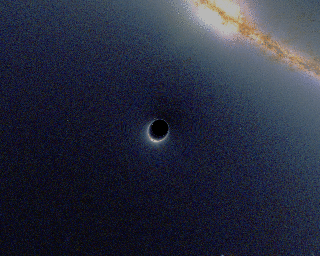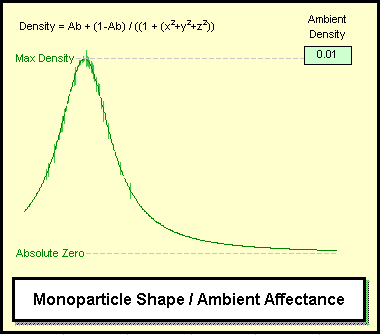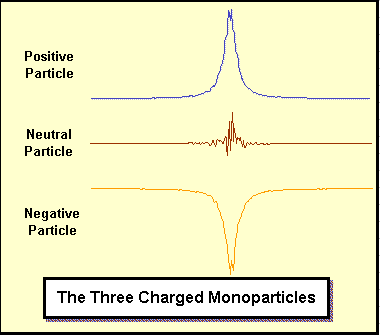Blueshift ponders… black holes – fact or fiction?
By Sara Mitchell. December 17, 2010

@ James S Saint
Google: search images - black holes , more than 1000 images of BH . . . .
google.co.th/search?hl=en&s … pxbT03dVt0
=====
Shouldn’t the light be being sucked inward, rather than being pushed outward?
What you see is the light that got bent around the object - everything outside of the event horizon. You don’t see the light that got too close. Thus two things are proven:
- The object is of extreme mass
- There is an affectance field (a “mass field”) extending well outside the event horizon (thus literally everything is not “pulled in”).
And despite what anyone might tell you, there is no “singularity” at the center of a black-hole. Physical singularities don’t exist.
Okay, it makes sense.
So when aether is piled up, it becomes dense, like matter.
Matter reflects light, but dense aether only slightly reflects light, like 10%, slightly altering its trajectory.
Actually it makes sense. If you study the process of light reflection, you see that light reflecting off objects is not a cut and dry matter of “angle of incidence” on a surface normal. In fact, it has a randomized surface normal at the atomic level, multiple round balls it must collide against, and so the normals tend to be averaged because of the randomized angles of incidence.
Dense aether would be a little bit different, rather than hard round balls it is like a ball bouncing off a gel, so its even more random than the angles of incidence on hard round balls, and also less effective at changing the trajectory, it is only a percent value of the expected normalized angle of incidence based on its viscosity.
I don’t know anything about aether. When affectance builds up it IS matter. Mass particles are merely extremely high density affectance field spots (like spots of mold on a window pane). The gravitational field surrounding the particles is merely far less dense affectance.

If you look at the last frame of that anima, you can still see a small remaining bump of the particle. Then imagine many of those little remaining bumps all skittering around each other. That is what is inside a black-hole. Near the center, they are much closer together and harder to distinguish from each other than further from the center.
That is exactly what I meant, you and I are exactly on the same page.
Superdense is when they become atoms, but dense is when they are the field around blackholes.
And you automatically get three type of particles:

One of increasing affectance potential (positron)
One of neutral affectance potential (neutrino)
One of decreasing affectance potential (electron).
And realize that the extended ambient field from the central concentration is what causes gravity. Those particles (much the same for light) migrate toward the more dense affectance field and thus toward each other. There is no “force” pulling on them. They merely drift, changing their center of congestion because the field is denser on one side, usually the side facing the other particle.
Many beautiful pictures.
Somebody knows to use Photoshop.
Behind Photoshop’s beautiful pictures is hidden our ignorance.
==…
You should make a video about the whole RM:AO that lasts about 20 or 30 minutes. The advantage is that such a video makes it possible to understand the whole RM:AO within 20 or 30 minutes and that you do not need to explain any single element of RM:AO again and again.
But this is a good exercize for James, repeating himself over and over, its good honest work and helps him with the flow.
For instance, Ill sometimes talk to nobody, about things and concepts, and it helps me iron out the flow, sometimes I even discover errors in it from time to time and it helps me fix those too.
Actors rehearse for movies. Teachers do too, in a way.
You guys have an astounding belief in atomos, that ultimately things cannot be further split [God particle stuff]. Strange when up until that point absolutely everything could be split!
Yes, that is right. And as far as I know him he wants some but not all people to challenge him because of that good exercize you mentioned.
I don’t know where you get your ideas of what we are talking about. You seem to always have it completely wrong and in this case exactly backward. RM:AO proposes that there is a substance that is infinitely divisible (unlike quantum physics - atomos). But there is a smallest particle size beneath which there can be no particles. That is quite provable and is a function of the speed of light.
Yes and no, but from where to begin? Everyone has their own confusions. RM:AO has an explanation for literally everything concerning it and that is a lot. So it isn’t so easy to just explain it all from the beginning. It isn’t just a vague notion of about how things are. Anything that truly answers all questions is not going to be a 20 minute video. There is just too much there.
But not having to repeat myself on every issue is why I use those pics and blog pages.
Black holes are simply vortices in the
underlying structure.
Atoms floating in Space are not floating
in Nothing: they are in a sea of the material that makes up atoms- call it aether, call it the next
fractal level down in I Fractal Universe.
Where this aether is spinning, it spins
much faster than our matter can spin, so
when our matter gets involved, it it
shredded. The charges actually repel
each other magnetically, because of the acceleration,
much more strongly than they can
attract each other electrically, and they
become two oppositely-directed jets
of High-energy particles.
a) A- bomb destroyed Hiroshima and Nagasaki.
b) Where did A-bomb’s masses come from?
They came from U-238
c) . . . etc.
=====…
a) Cold stars created black holes.
b) Where did cold star’s masses come from?
They came from hot stars.
c) Where did hot star’s masses come from?
“Hmm . . . . if I know where hot star’s masses come from,
then I didn’t need the rest scientific foolishness.” / Socratus /
==…
P.S.
The origin of supermassive black holes remains an open field of research.
en.wikipedia.org/wiki/Supermassive_black_hole
=.
Actually it is “affectance”, unlike aether a provable substance.
But I’m afraid that it is logically/mathematically impossible for the universe to be fractal. Although one can imagine such a thing, there can actually be no particles of any kind smaller than we already observe.
I am betting that someone answers the question long before Wiki publishes that the question has been answered. ![]()
And the mass of all stars comes from the prior collision of black holes (and/or neutron stars).
You should begin with the definitions, the defintional logic, your concept of “existence”, of “affectance”, then show an example with a particle, of course. But maybe that you are right and a video is not the best medium to explain what RM:AO is, although it is possible to divide it into several "sub"videos: one for RM, one for AO, and more than one for other aspects of RM:AO.
Aether is a provable substance, aetheral wind is not.